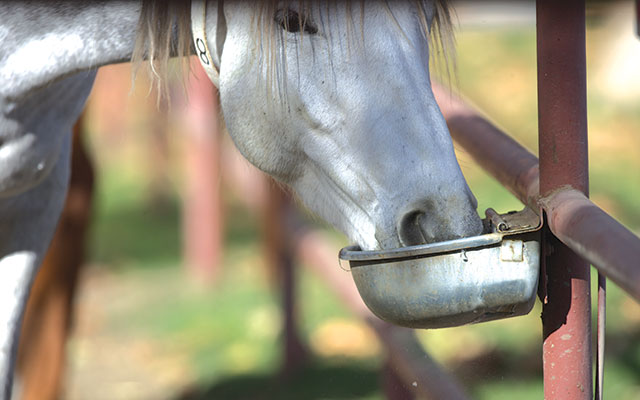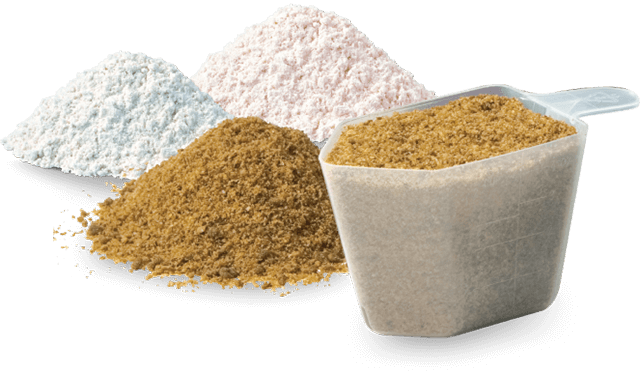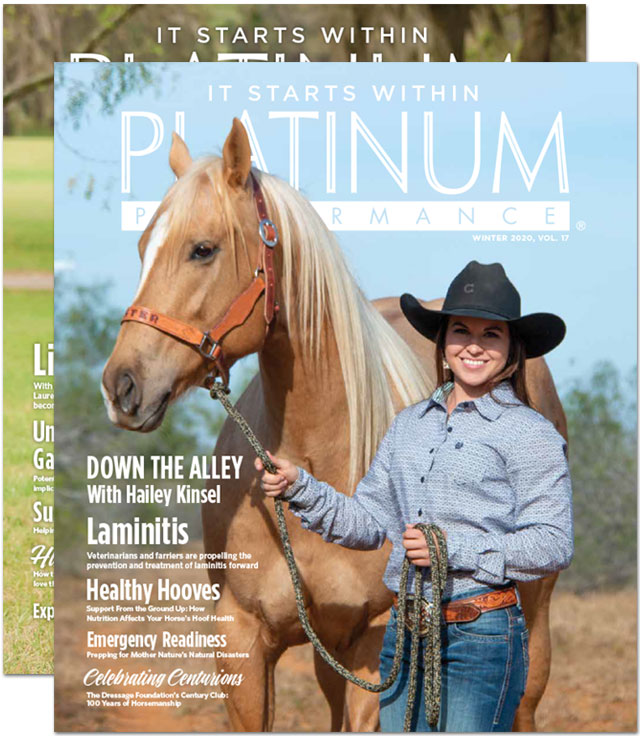Sweat is the major mechanism for removing excess body heat from the horse. The degree to which a horse sweats depends on several factors: environmental conditions, type of work or exercise performed and the horse’s individual fitness level. The act of sweating is really an incredible self-preservation action to prevent overheating through evaporative cooling to dissipate the excess heat produced. Sweat is essentially made up of water and specific charged minerals or electrolytes. Hydration and electrolyte replacement is vitally important for alleviating the risk of thermoregulatory dysfunction or failure associated with dehydration and electrolyte imbalances.
“With the intensity of traveling and training nationally and internationally, it’s very important that my horses stay well hydrated. Platinum Performance’s electrolytes are a no-brainer for me in my program. It’s a simple powder that I put in my horses' grain in the morning before travel or competition, and my horses love it!”
— Caroline Martin
Winner, 2017 Carolina International CIC3*, Top Under 25 Rider in North America, 4-Time USEA Young Rider of the Year & Platinum Performance® Client since 2016
Water is Life
Water is the most important nutrient for all life, and deprived of it, a horse can perish within 48 hours. Fresh, clean water should be available at all times. Working horses should be offered water at least once an hour during extended periods of exercise. Water is critical because it is incorporated into every cell of the trillions within the body. Making up nearly 70 percent of the horse’s total weight, the horse needs water to see, hear, breathe, move, to lubricate the joints, cushion the nervous system, thermoregulate, digest food and excrete wastes.
To hydrate, horses drink water, but they also ingest it from various feeds, hay and pasture, and are even capable of creating their own metabolic water through the breakdown of carbohydrates, proteins and fats. Drinking water is certainly the most efficient method of hydration. The average horse will stop and drink 8 to 20 times each day dependent on temperature, humidity and amount of work and exercise. How much a horse drinks depends on age, life stage, exercise level and the ambient temperature. An average-sized mature horse will drink between 5 to 10 gallons per day at a moderate temperature of 68 degrees Fahrenheit. As temperatures increase, the amount of water consumed increases significantly. Water consumption will range between 11 to 15 gallons for the same horse at 86 degrees Fahrenheit, and that same horse exercising moderately in 95 degrees Fahrenheit will consume 19 to 24 gallons of water. It is also important to note that water consumption is typically thought of as more of a concern during hot weather months when horses are usually producing more sweat. Winter water consumption, however, is extremely important as well, as horses typically do not drink as well during cold temperatures. Adding salt during winter meals may encourage drinking or, if possible, heating the water to 50 degrees Fahrenheit can encourage drinking as well. In nature’s perfect way of balancing, water leaves the horse through several avenues including feces, urine, respiration, skin losses and sweat, and through milk during lactation.
Hormones regulate water balance and hydration. The antidiuretic hormone (ADH) is in charge of regulating sodium and water levels within the blood. If a horse does not consume enough water, ADH from the pituitary gland will signal the kidneys to retain water in order to dilute the blood. The horse will urinate less to conserve water, and the urine will become more concentrated. If the horse is consuming enough water but not enough sodium, the hormone aldosterone from the adrenal gland will signal the kidney to start saving sodium and will excrete potassium in the place of sodium. Due to increased excretion, it may seem logical that potassium would need to be supplemented back into the diet, but it is actually a lack of sodium that should be addressed. If adequate sodium is provided, the horse will drink enough water under normal conditions. Monitoring fluid balance in this way is one of the basic functions of electrolytes. It is an amazingly simple yet essential way that the horse’s body operates to naturally create these shifts of electrolytes which in turn will influence body fluids and other ions to adjust their concentrations for health.
“Event horses are some of the equestrian worlds’ hardest working athletes and sweat more than the average show horse. In my program, I find that by providing FRESH water and using electrolytes on a daily basis whether at home or on the road is of utmost importance as it helps keep our horses hydrated and in top condition to perform at their best.”
— Laine Ashker
USEA AEC Gold Cup Champion
Platinum Performance® Client since 2011
The Need for Electrolytes
Electrolytes are biological instruments. They maintain fluid balance and the body’s acid-base balance. They influence circulatory function and blood volume, as well as trigger muscle contractions and nerve impulses. Electrolytes are free, ionized minerals with an electrical charge circulating in a watery solution, such as blood or tissue fluid and in cells. The main electrolytes needed in the horse’s body include: sodium, potassium, chloride, magnesium and calcium. Phosphorus, zinc, iron, copper and manganese are also electrolytes. Sodium and chloride are the major electrolytes in blood and extracellular fluid, while potassium is the main intracellular electrolyte. All electrolytes are required for daily functioning and maintenance, which the horse typically consumes from a normal forage-based diet, with the exception of sodium. A typical pasture and/or hay diet provides plenty of reserves of potassium and chloride to meet the maintenance requirements of most horses but is nearly always deficient in sodium. For this reason, all horses should always have access to a plain white salt block or loose salt to satisfy sodium requirements.
Ensuring the horse has access to salt and fresh water goes a long way for proper hydration. Pasture or hay with free access to white salt blocks or loose salt will fulfill maintenance requirements for the electrolyte needs of most horses. Supplementary electrolytes become important when horses are sweating more than they would under normal, ambient conditions as the purpose of electrolyte supplementation is to replace what is lost through sweat. Most performance horses or horses training with heavy or prolonged work with significant sweating, especially in hot and humid weather, will require electrolyte supplementation as even mild dehydration can be harmful. Electrolyte deficiencies are associated with general fatigue, and muscle weakness and exhaustion that can lead to tying up (rhabdomyolysis), as well as reduced sweating, which can cause hyperthermia and compromised performance. Lethargy and reduced feed and water intake can preempt weight loss and dehydration associated with decreased intestinal motility and colic. Administering supplementary electrolytes is a very useful way to encourage the horse to consume water and remain in a positive water balance.

Electrolytes
Three things increase the rate of sweating and, therefore, elevate electrolyte requirements: heat, humidity and exercise intensity. In the horse, 65-70 percent of body heat is lost from the evaporation of sweat.
When a horse sweats, the requirements for electrolytes are substantially increased above maintenance requirements as sweat drains a huge quantity of electrolytes, particularly sodium, potassium and chloride.
Electrolytes & The Performance Horse
Three things increase the rate of sweating and, therefore, elevate electrolyte requirements: heat, humidity and exercise intensity. The purpose of sweating is to get rid of excess body heat. In the horse, 65-70 percent of body heat is lost from the evaporation of sweat. Body heat is a product of cellular metabolism and is exponentially increased from exercising muscles. The horse dissipates heat to some extent through respiratory avenues but mainly through perspiration. The ability to effectively eliminate heat while exercising is very important as to how it affects performance. Inadequate electrolyte intake to a performance horse can not only limit sweat production but can cause complications from dehydration. The dual function of electrolyte supplementation to the performance horse is that it both supports the actual ability to sweat as well as a way to ensure the horse stays properly hydrated with regards to both blood volume and extracellular fluid.
When a horse sweats, the requirements for electrolytes are substantially increased above maintenance requirements as sweat drains a huge quantity of electrolytes, particularly sodium, potassium and chloride. Sweat contains water, protein and a relatively high amount of sodium, chloride and potassium, and lower levels of calcium, magnesium and phosphate, as well as small amounts of trace elements like zinc, manganese and iron. Supplements should mimic the proportion of losses from sweat. Sweat contains about 80 percent as much potassium as sodium, and twice as much chloride as sodium. Horses in moderate work in cool weather probably do not require electrolyte supplementation. Performance horses or those exercising in hot climates and sweating will require electrolyte supplementation. Horses that are prone to tying up or muscle soreness should also consider electrolyte supplementation. Supplementing electrolytes post-exercise will effectively induce water consumption. Electrolyte losses should be replaced soon after exercise in most cases.
While all horses require free access to salt, not all horses require further electrolyte supplementation. Horses that are not sweating and live in temperate climates will not need additional electrolyte supplementation.
Water Intake Facts
5-10 gallons
Horses drink an average of 5-10 gallons of water daily at moderate temperatures
50-200%
Sweat losses increase water intake needs by 50-200 percent
19-24 gallons
A 1,100-pound horse exercising in hot or humid conditions for 1 hour will require 19-24 gallons of water to replace sweat and evaporative losses
2x more
If a horse is on a diet of dry hay only, water intake may double
3-4x more
Lactating mares may require 3-4 times the amount of water compared to an average horse to sustain milk output
50 degrees
Heating water during the winter months to 50 degrees Fahrenheit can encourage drinking
Preventing Dehydration
- Salt should be available free choice or administered daily to satisfy maintenance requirements of sodium. Electrolyte supplementation is specifically to replace minerals (including salt) lost through sweat.
- Plain white salt should be made available as a block or as loose salt, even while traveling at horse shows. Avoid mineralized (red) blocks, some horses will not eat them because they taste bitter. Or, if they are sweetened with sugar or molasses, they may consume too much. Horses do not self-regulate mineral consumption (with the exception of NaCl).
- A 5-pound salt block should be consumed within 2 months. If a horse is not consuming at this approximate rate, try offering loose salt instead. Salt block and bricks were created for cattle with rougher tongues and some horses do not like to use them. This may be useful to try especially in cold weather when the blocks are freezing and even less inviting to use.
- For maintenance purposes, one ounce of salt (~2 tablespoons) is an appropriate amount of salt per day to add to a horse’s diet in cool weather and can be doubled in hot, humid conditions.
- Every horse needs access to fresh water after they have been given electrolytes. If electrolytes are being offered in water, a fresh water source must be supplied as well.
- To prevent ulceration, give electrolytes with feed or wait until after the horse has eaten to administer. For orally-syringing electrolytes, use a liquid antacid or small amount of oil as the carrier for electrolyte powder.
- Administer electrolytes immediately after the horse has had a drink, preferably a few gallons.
- Electrolytes are minerals and will have a very long shelf life. It is a good thing to have some on hand at the barn when needed.
- Check the label. Electrolyte supplements should not have sugar in them. Salt should be the first and primary ingredient and at least 75 percent of the total. Also look for chloride or citrate combinations, such as potassium chloride or magnesium citrate as these sources are more readily absorbed.
Signs of Dehydration
Severe electrolyte deficiencies are a medical emergency and can result in complete exhaustion, colic, synchronous diaphragmatic flutter (thumps), collapse and death if not treated medically.
1
Pinch Test
The skin on your horse’s neck doesn’t quickly return to its place after pinching.
2
Mucous Membranes
The horse’s mucous membranes in the nose and mouth are dry or red.
3
Capillary Refill
When you press your finger on the gum, the spot should change from white to red quickly. The longer it takes the capillaries to refill shows the severity of dehydration.
A veterinarian should be contacted immediately if a horse is suspected to be acutely dehydrated.
Anhidrosis: System Overload
Anhidrosis, also called “dry coat syndrome,” is defined as the decreased ability or loss of ability to sweat in response to increased body temperature resulting in several clinical symptoms. It can be a very frustrating and often scary issue for horse owners and a devastating health problem for horses. Although the problem can affect any horse, it is most commonly diagnosed in performance horses. Research indicates anhidrosis affects up to 6 percent of all horses with no predilection for breed, sex, age or coat color, although some anecdotal evidence suggests dark-colored horses are more affected than light coat colors. Horses diagnosed with anhidrosis typically live in many of the southern states with warm, humid climates with a high proportion in the Gulf Coast states.
Those affected with anhidrosis are unable to dissipate body heat through normal sweating. The onset of anhidrosis seems to be dependent on the individual with some horses abruptly discontinuing to produce sweat, while others will have a decreased amount of total sweat over time or discontinue sweating in certain areas of the body. While the exact cause of anhidrosis is still unclear, one hypothesis is that the problem is at the level of the sweat gland being overstimulated by stress hormones. In response to high circulating levels of epinephrine, a sweat stimulator, there is first a desensitization followed by a decreased number of Beta-2 andrenergic receptor on the sweat glands. The sweat glands are then unable to sweat in response to circulating epinephrine, and in chronic anhidrosis cases, sweat glands ultimately atrophy. There are also early findings in current ongoing research to suggest the chloride transport across sweat gland cells may be reduced or compromised in anhidrotic horses causing an inability to sweat.
Commonly called “non-sweaters,” chronically affected anhidrotic horses may develop a dry, flaky skin, particularly on the forehead, as well as a thinning of the hair coat or hair loss. Exercise intolerance, lethargy and a slow rate of recovery post-exercise are often commonly reported. The athletic potential of affected horses is greatly limited, resulting in the loss of use unless the horse begins to sweat normally. It is a compromising situation for all horses but may be career ending for performance horses who cannot thermoregulate and are unable to perform work. Anhidrotic horses will often have an increased respiratory rate that can quickly become respiratory distress as they try to compensate heat loss through the respiratory tract. Labored breathing and flared nostrils are common symptoms as well as an elevated body temperature and increased heart rate. Severe cases can result in complete fatigue, hyperthermia, heat stroke and death. Due to the severity of the health problem, horses with anhidrosis should be in a management program closely overseen by a veterinarian.
Supplementing the Non-Sweater
Omega-3 fatty acids and antioxidants combined with specific nutrients such as, arginine and B Vitamins — B3, B6, B1 have been found effective to support normal sweating again in some horses.
The equine sweat glands are richly innervated with blood vessels; that blood supply is crucial for proper sweating. Arginine is an amino acid and an important nutrient in the formation of nitric oxide synthase (NOS). NOS is important in dilating blood vessels and appears to have an important function in equine sweating. It is also involved in the neurologic control of sweating. Tyrosine is a dopamine precursor, a neurotransmitter important for the horse to perspire. Vitamin C and vitamin E are antioxidants that support a horse when experiencing oxidative stress due to high body temperatures when the horse is unable to sweat. The B Vitamins — Vitamin B3, B6, B1 — are essential to proper cell and nerve function. The action of sweating in horses is partially controlled by nerve stimulation. Sodium, potassium and chloride are all important electrolytes in the horse’s diet and all are important components of sweat. If a horse has depleted their body stores of potassium, then sweating may be decreased.
Management Options
Aside from dietary adjustments, there are other management options to support thermoregulation in horses with anhidrosis. Many affected horses have been noted to effectively start sweating again once relocated to a cooler climate. As this may not always be possible, other therapy options may help to keep affected horses comfortable.
- Clean, cool, fresh water should always be available to encourage normal hydration.
- Providing shade during turnout or turning out at night.
- Fans in the stall are helpful to increase air circulation.
- Water misters can help to cool down as well as sponging or hosing off with cool water.
- If the horse tolerates exercise, opt to ride during the cooler hours of the day and dampen the coat prior to exercise.
- Monitor the horse’s respiration during exercise and allow for ample cool down time.
- Full body clipping may also further help to regulate the core body temperature.

How Platinum Can Help
Electrolyte Balance
Protocol: Administer 1 scoop of Platinum Performance® Equine* twice daily and 2 scoops of Platinum Electrolyte 1-2 times daily.
When: Supplement electrolytes after exercise, during hot or humid weather and other common causes of heavy sweating.
Anhidrosis (Non-Sweaters)
Protocol: Administer 1-2 scoops of Platinum Performance® Equine* and 1 scoop of Platinum Refresh® twice daily.
When: To help maintain normal sweating, begin supplementing 30-60 days before hot weather. Horses with chronic cases throughout the year can also be supplemented continuously.
* Platinum Performance® CJ or Platinum Performance® GI may also be used in place of Platinum Performance® Equine

by Emily Smith, MS,
Platinum Performance®

